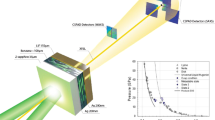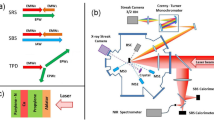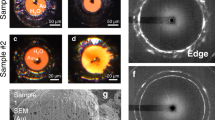Abstract
SHOCK excitation of a wide range of powdered inorganic solids (mainly metallic oxides) by helium driven shock-waves in argon1 has not only provided a powerful means of producing relatively clean spectra of astrophysically important diatomic molecules2, but also has given some insight into the physical processes which take place when the powder particles undergo severe thermal transients. From the general observation that molecular spectra alone are excited (in the hot stagnant region behind the reflected shock wave) at low temperatures (∼2,000° K.), mixed molecular and atomic spectra are excited at intermediate temperatures (∼5,000° K.) and entirely atomic spectra are excited at high temperatures (∼10,000° K.), and from other experimental considerations (refs. 1a and 1c), it is thought that a predominantly atomic vapour is evaporated from the solid inorganic surfaces, which, if the temperature is low enough, partially or completely recombines to form diatomic species. It is therefore a logical extension of this work to examine the variation with environmental temperature of the spectra from shock excitation of powdered organic materials, and in this communication experiments with benzene, naphthalene, and anthracene are discussed.
This is a preview of subscription content, access via your institution
Access options
Subscribe to this journal
Receive 51 print issues and online access
$199.00 per year
only $3.90 per issue
Buy this article
- Purchase on Springer Link
- Instant access to full article PDF
Prices may be subject to local taxes which are calculated during checkout
Similar content being viewed by others
References
(a) Parkinson, W. H., “Shock Excitation of Powdered Solids”, M.Sc. thesis (University of Western Ontario, 1957); (b) “Studies on the Shock Excitation of Powdered Solids”, Ph.D. thesis (University of Western Ontario, 1959). (c) Parkinson, W. H., and Nicholls, R. W., Scientific Report No. 1, Contract AF 19 (604)4560 1959, University of Western Ontario; (d) Scientific Report No. 3, Contract AF 19(604)4560 1959, University of Western Ontario.
(a) Nicholls, R. W., and Parkinson, W. H., J. Chem. Phys., 26, 423 (1957); (b) Canad. J. Phys., 36, 625 (1958). (c) Nicholls, R. W., Watson, M. D., and Parkinson, W. H., J. Roy. Astron. Soc. Canad., 53, 223 (1959).
Greene, E. F., J. Amer. Chem. Soc., 76, 2127 (1954).
Fairbairn, A. R., and Gaydon, A. G., Proc. Roy. Soc., A, 239, 464 (1957).
Campbell, C. E., and Johnson, I., J. Chem. Phys., 27, 316 (1957).
Parkinson, W. H., and Nicholls, R. W., Canad. J. Phys., 38, 715 (1960).
Porter, G., Fourth Int. Symp. Combustion, 248 (Reinhold, New York, 1952).
Greene, E. F., Taylor, R. L., and Patterson, W. L., J. Phys. Chem., 62, 238 (1958).
Author information
Authors and Affiliations
Rights and permissions
About this article
Cite this article
NICHOLLS, R., WATSON, M. Shock Excitation of Solid Aromatic Hydrocarbons. Nature 188, 568–569 (1960). https://doi.org/10.1038/188568a0
Issue Date:
DOI: https://doi.org/10.1038/188568a0
Comments
By submitting a comment you agree to abide by our Terms and Community Guidelines. If you find something abusive or that does not comply with our terms or guidelines please flag it as inappropriate.



